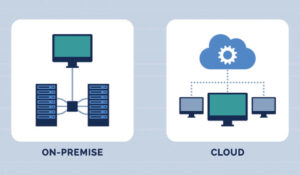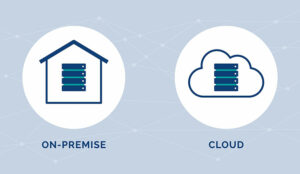Simon Adnett at Enghouse takes a look at cloud vs. on premise contact centres and explains why it’s a matter of contact centre choice.
No two organisations are the same, meaning their contact centre choices around technology need to reflect their specific needs.
This is particularly true when it comes to the cloud, with many contact centres deploying Contact Centre as a Service (CCaaS) solutions.
However, the cloud isn’t necessarily right for everyone. Some organisations have strong reasons to retain their systems on-premise.
Alternatively, they may want to adopt a hybrid approach incorporating a blend of cloud and on-premise solutions.
To achieve this, it’s essential to work with a partner that has the flexibility to support contact centre choice.
Why Organisations Want to Keep Contact Centre Solutions On-Premise
There are a range of reasons for keeping customer service solutions on-premise, including:
1. Meeting Regulatory Requirements
In some heavily regulated sectors such as defence and healthcare, organisations must meet specific, additional rules around data confidentiality and security.
That means the safest approach is to keep their data protected in a closed data centre, with no access to the internet.
This insulates their information from being hacked or stolen. In these situations, on-premise delivers the security protection that organisations require.
2. Integrating with Legacy Telecoms Systems
Contact centre solutions integrate closely with internal PBX telecoms systems. Therefore, if the legacy PBX is on-premise, it may be easier and simpler to keep the contact centre technology on-premise as well.
When integrated and co-located in the same location, the two systems can work closely together taking and routing calls and providing a seamless experience internally and externally.
3. Integrating with Legacy Line of Business Systems
Organisations have built their technology stacks up over time, with many components, like CRM, case management or logistic solutions, potentially on-premise.
Contact centres may depend on data from these systems to help customers with their enquiries.
This can restrict what you can do on the cloud. Again, maintaining contact centre solutions on-premise can often simplify integration to other platforms.
4. Maximising ROI of IT Infrastructure
Organisations may have invested heavily in their own physical or virtualized server infrastructure.
They therefore need to maximise ROI from these assets and ensure they are being used at full capacity.
That means it may make better business sense to use them to run contact centre solutions, rather than switching to the cloud.
5. Taking a Hybrid Approach
While businesses often decide to embrace the cloud, they prefer to migrate gradually to minimise risk.
This can lead to adopting a hybrid approach, keeping some contact centre systems on-premise while migrating others, such as new solutions, to the cloud. This enables them to move to CCaaS at a pace they are comfortable with.
6. Having a Different Strategic Approach
In some cases, the contact centre’s choice of whether to go cloud or on-premise may be part of a wider technology or infrastructure strategy.
For instance, an organisation may simply be committed to investing in its own internal IT skills.
Part of this strategy involves keeping their systems on-premise. They might mandate that there are no cloud implementations of any systems as part of their vision of how they want to manage their IT infrastructure.
Picking the Right Vendor to Guarantee Choice
All of these are valid reasons for keeping all (or part of) your contact centre solutions on-premise.
However, needs can change. Organisations should therefore partner with a vendor that can support their requirements and approach, now and into the future. Here are the key things to look for in a partner:
1. Able to be Flexible
You need a vendor that supports both CCaaS and on-premise solutions across its entire product portfolio. If required, it should be able to provide hybrid options or enable the business to run its contact centre technology in a private cloud.
Flexibility should extend to pricing. While everyone understands that CCaaS operates on a “pay per use” subscription basis, some vendors now offer a similar, rental OPEX model for on-premise solutions too.
This is a good choice if you need to run on-premise but want to smooth your cash flow.
2. Delivers Equal Functionality
While some vendors do offer both cloud and on-premise options, they may not provide the same features across both. It’s important to check that your partner’s solutions have the same high levels of functionality across the board.
Do they provide the same agent user experience? Are the same integrations with third-party solutions available? Do you get identical levels of support?
3. Provide a Roadmap for the Future
If your strategy is to stay on-premise for the long term, you need to be sure that this isn’t going to disadvantage you in the future.
So, your chosen vendor should be able to demonstrate a clear product roadmap for both its cloud and on-premise solutions.
It needs to be investing and innovating into the future to ensure you do not miss out on whichever direction you take.
4. Enable You to Move Between the Two
While your strategy may be to stay on-premise, priorities can change. This shouldn’t mean you need to rip out your existing solution and start again in the cloud.
Ensure your partner provides the ability to migrate seamlessly between on-premise and cloud should you decide change is in your organisation’s best interests.
5. Control
With shared cloud platforms (public clouds), it is common for providers to communicate about when platform updates and maintenance periods will happen with customers ahead of time.
However, your organisation’s operating hours might not align with scheduled change windows. An on-premise or private cloud contact centre allows complete control over what changes are made and when they happen.
While the momentum in the contact centre industry is currently with CCaaS, it may not be exactly what every organisation requires.
Some businesses may need to keep some or all of their solutions on-premise over the short or longer term.
If you are in this position, ensure you pick a partner that gives you this contact centre choice, with the same levels of support and functionality going forward.
This blog post has been re-published by kind permission of Enghouse Interactive – View the Original Article
For more information about Enghouse Interactive - visit the Enghouse Interactive Website
Call Centre Helper is not responsible for the content of these guest blog posts. The opinions expressed in this article are those of the author, and do not necessarily reflect those of Call Centre Helper.
Author: Enghouse Interactive
Published On: 16th Nov 2023 - Last modified: 9th Dec 2024
Read more about - Guest Blogs, Enghouse Interactive






 Enghouse Interactive delivers technology and expertise to help bring your customers closer to your business through its wide range of customer contact solutions.
Enghouse Interactive delivers technology and expertise to help bring your customers closer to your business through its wide range of customer contact solutions. 





























